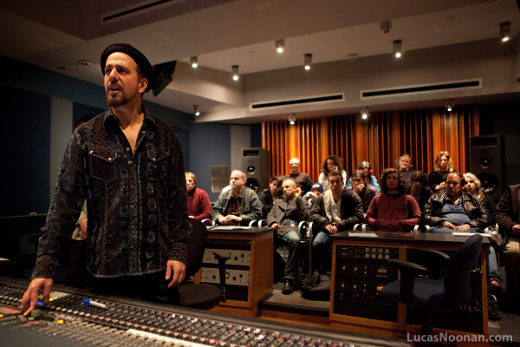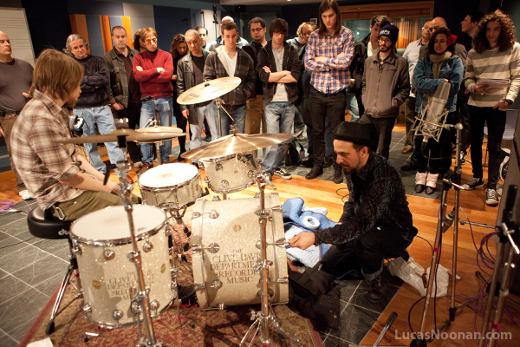Master Class: Learn “The Art of Recording Classic Drums” with Rich Pagano of the Fab Faux
GREENWICH VILLAGE, MANHATTAN: Earlier this year, one of NYC’s top session and touring drummers, Rich Pagano, shared some of his studio expertise in an intensive way.
His academic vehicle? A six-part hands-on course he lead at NYU’s Clive Davis Institute of Recorded Music entitled “The Art of Recording Classic Drums.” Attendees — engineers, producers, and drummers who were serious about advancing their drum-recording abilities — got to work in close quarters with Pagano, a member of the Fab Faux who also sports countless records and network TV credits, along with his status as founder of New Calcutta Studios in the garment district.
A hands-on course, “The Art of Recording Classic Drums” provided some priceless advice, covering techniques of instrument and head selection, miking, tuning, and recording the “classic” drum sounds typified by some truly classic drummers and producers: Ringo Starr, Phil Spector’s Wall of Sound (courtesy of Hal Blaine), Rudy Van Gelder’s jazz sound ( as exemplified by Miles Davis), Keith Moon, late ‘70’s Charlie Watts, Motown, Nigel Olsson (early Elton John), drum sounds of the early 70s and John Bonham.
Pagano recently made some of the recordings from the workshop, complete with session notes, available to SonicScoop. For an intensive drum tip fix, listen, read, and learn from these sharply performed and tracked SoundCloud files, accompanied with detailed information on the recording techniques that were applied.
A new course in the series has also just been announced. To register for the next edition of “The Art of Recording Classic Drums”, starting January 7th, visit here.
Get a visual taste of the action, then be sure to check out all the SoundCloud files and session notes that follow, below.
______________________________________________________________________
SoundCloud Set One: ” ’70’s Drum Day”
#1 — Final “All Mics”
“DIARY: 70s Drum Sounds – Class started by listening to Al Green, Don Henley (Eagles), Nigel Olsson, Fleetwod Mac, Mott The Hoople, The Carpenters and Phil Collins (creativity through audio gates). Note: This particular class was filmed for a documentary. We talked about single headed drums, type of heads, baffling a room and surrounding the drum set with hung packing blankets (we did this). We then set out to manipulate an early 70s Ludwig Vistalite (red). We did not A/B the records with our drum sound since we wanted to make a bit of a hybrid of all sounds listened to.
Drums: 22×14, 8×12, 9×13, 10×14, 16×16, 5 1/4×14 snare (chrome) this was the only kit used at the classes with clear heads and all bottom heads were removed except for the floor tom. Kick was tuned and packed tight but still with some low thud tone, toms were taped up at the top of the head with some paper towels being used and tuned low-ish. Floor tom was also taped and paper toweled on top and a bit on the bottom. Snare had an O-ring plus ‘taped on’ paper towel. Much time and care was taken to make sure that the tone of each tom was consistent with the other.
Mics: Toms: Senn 421s at the bottom of the shells and just outside , Kick close Senn E902, Kick far Senn 441 (drums were facing a corner so that we could use the space in front of the bass drum for kick drum air and low end). Bass drum mics were then covered with a moving blanket draped over chairs. Snare top and bottom 57s, overheads 57s right on the cymbals, room mics 87s from behind the kit. Kick close was pushed into a REAL (hardware) 1176. Much care was put into checking phase. I performed a bit and we then mixed it all in stereo into an 1176 plug in and a Focusrite 6 band EQ plug in to trim some bottom off, fatten low mids and add some overall top. Kick and snare were gated at this stage and a slap delay was added to the tom bus master (also gated). A touch of plug in reverb (EQ’d) on the snare too.”
#2 — “Close Mics”
#3 — “Overhead & Room”
Set Two: “Glyn Johns Day”
#1 — Final “All Mics”
“DIARY: Glyn Johns Day’s drum sound (and Eddie Kramer too) arrived through tangible info and hypothesis. We looked at photos (Bonham, Watts), talked about my conversations with Chris Huston (Led Zep 2) and Henry Hirsh (Lenny Kravitz) and listened to Led Zeppelin and The Rolling Stones. We turned the music off, tuned the kit and started to create a drum sound – never A/Bing the source again so that we could have a bit of our own personality in the sound.
Kit: 24 x 16 (forgot to use a wood beater ala, Bonham), 9 x13, 16 x 16, 14 x 7 snare. I did not list mics used but remember that we had an 87 as a single overhead and a Schoeps cardiod behind the kit and near the floor tom, Snare top only (57), kick front (no hole in the head) Beyer M88, behind the kick is a Sennheiser 441 (about one foot behind the thone, 2 ft off the ground).
Room mics were Coles mics and were about 12 – 15 ft in front of the kit and placed wide. Every mic was strategically placed for optimum tone and impact. I performed the drumming and then we mixed it all in mono except for a slight pan on the rooms. All mics were bussed to an 1176 type plug in and with a little bit of high and low pass EQ also on the bus. Reverb was added through a plug in and EQ’d to sound vintage (lots of low pass filter manipulation). See other stems for isolated mics on this kit.”
#2 — “Room Mics Only”
Set Three: “Geoff Emerick Day”
#1 — Final “All Mics”
“Diary: Geoff Emerick Day (Ringo Blond Kit). We started by listening to Abbey Road and looking at ‘confirmed’ studio photos. I talked at length about what I learned from doing a session with Geoff and how forthcoming he was with recording info. We then set out to tune, baffle and ‘tea towel’ the drums (early ’60s Ludwig). We did not A/B the records to our sounds since we wanted a bit of the room’s personality in the end.
Drums: 22×14, 9×13 (didn’t have a 12″ available), 9×13, 16×16, 5 1/4×14 snare (chrome-only choice we had). Snare and floor were totally dampened, rack toms were taped slightly to emulate calf skin heads, floor and kick were with only a single head. Snare was miced with a Scheops cardiod from the BOTTOM ONLY. Single overhead was an 87. Double headed rack toms were miced at the ‘bottom of the shells at the head’ and the floor was miced from below (Scheops), just outside of the open shell. Much time and care was taken to get the mics and phase correct.
Room mics were Coles. I performed a bit and then we mixed it quasi-mono (panned left) into a Fairchild compressor plug in and a high pass filter plug in but with a bit of the rooms peeking through on the right to get a bit of the ‘The End’ sound (drums were in stereo). Snare sound takes on more of a Revolver/Sgt Pepper period sound – not as tightly baffled as ’69 but still with lots of ‘chick.’ Note: Close mics stem has a nice Ringo option too.”
#2 — “Overhead and Room Mics”
#3 — “Close Mics”
Set Four: “Rudy Van Gelder Blue Note Day”
“Diary: Rudy Van Gelder Jazz drum sound. We listened to John Coltrane, Jimmy Smith and talked about the shroud of secrecy surrounding the RVG sound. I had found some hypothesis online that seemed to be right but the rest was nothing more than guesses after listening to source audio. We set out to the live room (we did not A/B the records beyond this point, going for what the room is telling us) to an early ’60s ludwig kit.
Drums: 14×22, 9×13, 16×16, 5 1/4×14 chrome snare. Drums were tune high and with lots of resonance.
Mics: Overhead Brauner VM1(?) Large diaphram condenser, snare Scheops hyper cardioid, rack tom 87 (not used here), floor 87, room Coles (mono). The over head was way up in the ceiling (the sweet spot for this sound), the floor mic was way back and the room mic was 20 ft. in front of the kit, swiveled around and facing the control room glass with the protective Coles glove left on the mic to round off and muffle the sound – a lot. NY drummer Neil Nunziato played on this one. Mix was in mono and bussed to a Fairchild plug in and a low pass filter to make it all sound that much more vintage. Reverb (EQ’d) was also added.”
Set Five: “Rudy Van Gelder Day as an R&B/Motown Sound”
“All Mics”
“Diary: The Van Gelder sound lent itself to a decent R&B sound. Most of the Motown drummers were jazz drummers first and tuned their drums as such. The micing hadn’t changed from the VGelder sound but we did pull the room levels down, brought the rack tom 87 mic into the mix (it was not used for the ‘jazz’ sound) and baffled the front kick head a bit more (no hole) to give it more punch (we pushed a packing blanket up against the head). I played the drums and then went into the control room to mix – in mono. Verb and low pass filter is at the same settings as the jazz sound. See above info for the mics used.”

The Fab Faux drummer pointed the way in the control room as well as around the kit. (Photo by Lucas Noonan)
— David Weiss
Please note: When you buy products through links on this page, we may earn an affiliate commission.








chris keyes
November 9, 2012 at 12:10 am (13 years ago)Jealous! Are these seminars available to the public?
mvo
November 9, 2012 at 10:07 pm (13 years ago)What is the price to attend this class?
jojo deluxe
November 13, 2012 at 8:40 pm (13 years ago)man i wish this was coming to LA. maybe a video series for the rest of us that cant attend?
richpagano
December 11, 2012 at 10:49 am (12 years ago)Hi Jojo, I am bringing this around the country so LA is not out of the question. I have details on how to make it possible. Please send your contact to info@richpagano.com and i will send you info.
richpagano
December 11, 2012 at 10:54 am (12 years ago)Hi MVO, best thing to do is to call the number below. I heard that there are a few spots left.
The Tisch Office of Special Programs is open Monday-Friday, 9 a.m.-5:00 p.m. (EST). Call us at 212-998-1500 if you’d like to speak to someone about your application or inquire about courses or programs for NYU, visiting, and high school students. Fax number is 212-995-4578 or email: tisch.special.info@nyu.edu
Specify the name of the class: REMU-UT 1070 The Art of Recording Classic Drums
Hope to see you.
richpagano
December 11, 2012 at 10:57 am (12 years ago)Yes – only this one. The school purposely made it available to anyone. We will be doing it again in the spring but that series is only for NYU students so here is your chance to be on the inside ;?)….see above response to get in touch and retrieve info.
Hope to see you.